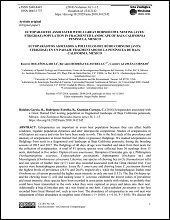ECTOPARASITES ASSOCIATED WITH A GREAT HORNED OWL NESTING (AVES: STRIGIDAE) POPULATION IN FRAGMENTED LANDSCAPE OF BAJA CALIFORNIA PENINSULA, MEXICO
ECTOPARÁSITOS ASOCIADOS A POLLUELOS DEL BÚHO CORNUDO (AVES: STRIGIDAE) EN UN PAISAJE FRAGMENTADO DE LA PENÍNSULA DE BAJA CALIFORNIA, MÉXICO
Autor
RAQUEL BOLANOS GARCIA
RICARDO RODRIGUEZ ESTRELLA
MARIA DEL CARMEN GUZMAN CORNEJO
Metadatos
Mostrar el registro completo del ítemResumen
"Ectoparasites are important in avian host population because they can affect health condition, regulate population dynamics and alter interspecific competition. Studies of ectoparasites in wild raptors are scarce and even few have been made in owls. This is the first study of the prevalence and intensity of ectoparasites in Great Horned Owl (Bubo virginianus) fledglings. We studied ectoparasites on fledglings from nests in a fragmented arid landscape at Baja California peninsula, during the breeding seasons of 2015 and 2017. The fledglings of 40 days of age were handled and taken from their nests for the collection of ectoparasites. A total of 81 epizoic species were collected from 36 nestlings from 15 nests, distributed in five orders: Diptera (Icosta americana); Hemiptera (Cimicidae gen. sp.); Phthiraptera (Neohaematopinus sciurinus, Colpocephalum pectinatum); Siphonaptera (Orchopea sp.) and Mesostigmata (Ornihtonysus sylviarum). Likewise, one species of chewing lice (n=5) (Geomydoecus telli) and one species of feather mite (n=7) were also recorded associated with the Great Horned Owl. Five species were hematophagous parasites. Louse fly I. americana and chewing louse C. pectinatum showed the highest levels of prevalence (26.5% and 20.6% respectively), while the hematophagous feather mite Ornihtonysus silviarum presented the higher mean intensity in only one nest (15.5). The flea Orchopea sp. and the chewing louse G. telli and sucking louse N. sciurinus exhibited the lowest values of prevalence and mean intensity; these species have been recorded in association mainly with rodents, so probably they could have been transmitted to the owls when they were captured as preys and taken into their nest. Additionally a bug (Cimicidae gen. sp.) was found in one host. Colpocephalum pectinatum is the first recorded from Great Horned owl, such as new host. The abundance of ectoparasites in one owl nest was independent of their abundance in neighbor nests (Moran´s I = 0.010; z = 0.16, P > 0.05). We discuss the implications of ectoparasitism for a Great Horned owl population in fragmented habitat of the Baja California arid desert." "Los parásitos juegan un papel importante en la historia de vida de sus hospederos porque pueden afectar la salud, regular la dinámica poblacional e inclusive alterar la competición inter-especifica. Bajo ciertas condiciones de deterioro del hábitat, como la fragmentación, puede aumentar los niveles de infestación y en consecuencia tener efectos negativos más marcados en los hospederos. Este es el primer estudio de la prevalencia e intensidad de ectoparásitos en volantones de Búho Cornudo Bubo virginianus. Evaluamos los ectoparásitos en pollos de nidos situados en un paisaje árido fragmentado de la península de Baja California. Los pollos casi volantones de 40 días de edad fueron tomados del nido durante las temporadas reproductivas del 2015 y 2017, para realizar la colecta de ectoparásitos y regresarlos posteriormente. Se colectaron 81 ectoparásitos de 36 polluelos en 15 nidos. Fue registrada una infestación del 61% (n=22) con ocho especies (H = 1.56), cinco de las cuales fueron parásitos hematófagos. Los ectoparásitos estuvieron distribuidos en cinco órdenes; Diptera (Icosta americana); Hemiptera (Cimicidae gen. sp.); Phthiraptera (Neohaematopinus sciurinus, Colpocephalum pectinatum); Siphonaptera (Orchopea sp.), y Mesostigmata (Ornihtonysus sylviarum). También se registró una especie de piojo masticador (n=5) (Geomydoecus telli) y una de ácaro de plumas (n=7) asociados con el búho cornudo. La mosca piojo I. americana y el piojo masticador C. pectinatum presentaron alta prevalencia (26.5% y 20.6% respectivamente), mientras que el ácaro hematófago O. silviarum presentó la más alta intensidad media en un sólo nido (15.5). La pulga Orchopea sp., y los piojos, masticador G. telli y succionador N. sciurinus, fueron registros raros y exhibieron los valores más bajos de prevalencia e intensidad media; estas especies se han registrado en asociación principalmente a roedores, así que probablemente se transmitieron a los pollos al llevar presas de roedores al nido del búho. Adicionalmente una chinche Cimicidae gen. sp., se encontró en un huésped. Colpocephalum pectinatum es primer registro para el Búho cornudo como hospedero. La abundancia de ectoparásitos en un nido de búho fue independiente de la abundancia de nidos cercanos (Moran´s I = 0.010; z = 0.16, P > 0.05). Se discuten las implicaciones que tienen los ectoparásitos en una población del Búho cornudo en un hábitat fragmentado del desierto árido de Baja California."
Colecciones
Ítems relacionados
Mostrando ítems relacionados por Título, autor o materia.
-
PROMOCIÓN DEL PERIFITON PARA EL CULTIVO DE CAMARÓN BLANCO: HACIA UNA ACUICULTURA ECOLÓGICA
DOMENICO VOLTOLINA LOBINA; JUAN MANUEL AUDELO NARANJO; MARIA DEL ROSARIO PACHECO MARGES -
Suelo y Erosión
YOLANDA LOURDES MAYA DELGADO


